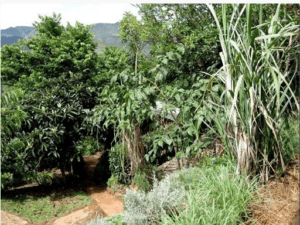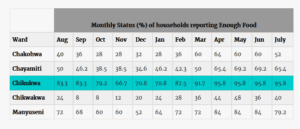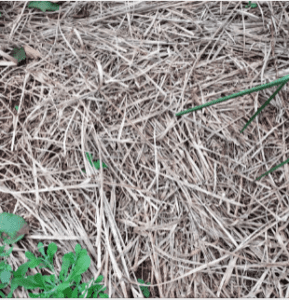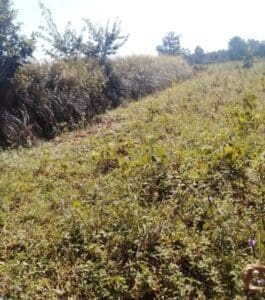This month’s newsletter gives some focus to vetiver, and its role as a potentially important component in permaculture practices, regenerative agriculture and the restoration of degraded lands, particularly in tropical and semiarid areas of the world. Those who know intimately the value of using Vetiver Grass Technology (VGT) for its

multiple applications and many benefits have to ask why more people are not using the technology to meet the challenges of climate change as they relate to soil health, degrading lands and water, and poverty.
Recently I revisited information about the Chikukwa Ecological Restoration program in eastern Zimbabwe. It was in 2012 touted as the largest permaculture (600 ha) program in the world and from Google Earth imagery it may by now have extended to 3000ha or more (note in western Ethiopia there is as much as 30,000 ha of vetiver protected land some of which would definitely be defined as regenerative agriculture. The Chikukwa program started in the 1990s and is still in operation. From the start vetiver was a critical component, generally planted as contour barriers at about 2 m VI, on slopes of 5-25% to control erosion The various reports on the program take note of this, but do not make

any other observations except for its value for soil conservation. It appears that its other benefits were either not observed or not known at that time. Here are two links to interesting articles about Chikukwa … Vetiver – One Grass Revolution and The Chikukwa Permaculture Project (Zimbabwe) – The Full Story
Nowadays we get feedback from India, Africa, Vietnam and other countries showing that when vetiver is totally integrated into farm management/garden practices and planted in very close association with food crops and perennials, some interesting results materialize- – most of which are associated with some of the unique vetiver attributes and how they relate to soil organisms (especially arbuscular mycorrhiza), and the interaction of the latter with both vetiver and adjacent plant growth.

Permaculture is a holistic design system and a philosophy that aims to create sustainable and regenerative living systems by mimicking the patterns and relationships found in nature. It encompasses various aspects of human habitation, including agriculture, architecture, energy, water management, and social organization. Vetiver is unique amongst plants that can do this under many different designs.
Permaculture objectives, generally associated with small farms and gardens, are to create resilient, diverse, and interconnected systems that work in harmony with the natural world, minimizing waste and maximizing well-being for all living beings. It offers a pathway to regenerative living, fostering a deeper understanding and connection with the environment. The Vetiver Grass Technology (VGT) can provide a very comprehensive tool to support permaculture land management practices and VGT aligns with many permaculture principles as shown below:
- Observe and Interact: We can see how vetiver can mimic nature, and in its various architectural options the user has multiple ways of bringing nature and vetiver in harmony. The natural properties of vetiver grass ensure, when properly configured, a sustainable solution for soil erosion control and water management – both essential for reestablishing and sustaining soil health, plant growth, and the global hydrological cycle.
- Catch and Store Energy: Vetiver grass captures rainwater, reduces soil erosion and runoff, and recharges groundwater aquifers. By spreading rainfall runoff it assures vital water for soil microbial function and the optimization of plant growth, better use of energy from sunlight, and the photosynthetic processes vital for survival of all living organisms.
- Obtain a Yield: The Vetiver System produces multiple benefits, including soil stabilization, water conservation, removal of toxic chemicals, and habitat creation for beneficial birds, insects and microorganisms, that together assures sustainable and profitable harvests.
- Apply Self-Regulation and Accept Feedback: The system self-regulates through the natural growth and design configuration. Feedback and monitoring results in easily made and non-destructive design changes to further improve benefits.

Photo 3. Hedgerows like this were planted in 2020 by Christian Makokha on a farm at Mumias, western Kenya. Over 2m tall with a huge biomass. This hedge is being reserved for harvest as a thatching grass. All erosion between hedgerows has been halted, rainwater is spread over the field below the hedge providing an even “irrigation” evident by the evenness of the crop. It also acts as windbreak and host diverse birds, insects, and small mammals. It can provide the mulch, as shown in photo 2, and a lot of it , as much as 1000-2000 kg/100m hedgerow. It is drought-proof and totally non-invasive. - Use and Value Renewable Resources and Services: Vetiver grass is a renewable resource, and provides ecosystem services like soil health, the enhancement of biodiversity, improved water quality and storage.
- Produce No Waste: The vetiver grass eliminates waste through a natural, non-toxic, and biodegradable solution, including negating or significantly reducing the reliance on a wide spectrum of agricultural chemicals.
- Design from Patterns to Details: The system follows natural topographical patterns using vetiver’s growth habits and appropriate designs to reduce rainfall runoff and delivering a swarthe of slow and soil soaking movement of water delivering maximum moisture benefits for plant growth
- Integrate Rather than Segregate: Vetiver integrates with existing ecosystems, enhancing their resilience and biodiversity. Importantly, when applied for land restoration, it enhances the rehabilitation of the natural environment, its growth and diversification.
- Use Small and Slow Solutions: The Vetiver Grass Technology favors small-scale, slow-growth solutions that build soil health and ecosystem resilience over time. Vetiver is scale neutral and will work for both infinitely small landscapes to very large.
- Celebrate Diversity: The vetiver grass applications, in whatever form or end use, promotes biodiversity by creating habitat and micro-climates that enhance a range of beneficial organisms and plant species.
By aligning with these permaculture principles, the Vetiver Grass Technology demonstrates how a nature-based solution can create regenerative and sustainable outcomes for soil, water, ecosystem health. It is low cost and extremely effective.
Scientific and or farmer practice data supports vetiver grass attributes and potential. (see data included in the many papers collected under TVNI’s Document Center – https://www.vetiver.org/network-services/document-center/
We need to do a better job at promotion, demonstration and promotion. For example Thailand has made huge efforts at introducing the technology, but even there uptake and change has been slow. Some of the reasons for slow up take include:
- Land ownership – lack of motivation to conserve rented land.
- Limited farm size and in some cases land shape, leading to an unwillingness to devote “space” for vetiver hedgerows.
- Insufficient realization of how serious soil loss can adversely affect growing plants.
- Lack of knowledge about all the benefits of vetiver grass.
- Insufficient attention to community participation, training and demonstration.
- Insufficient attention and use of farmer owned demonstration sites that are needed for training and visits by other farmers.
We find similar constraints in other countries. The good news is that evidence from Thailand, Vietnam, India, Kenya and others indicates that vetiver can be used at very small scale (including kitchen gardens); reducing or elimination the use of agricultural chemicals and costly inputs, and if properly introduced to farmers, along with other practices such as composting can be fully integrated as a regenerative agricultural practice. … AND, where used correctly, is very effective. For example in Kenya, Caleb Omolo and colleagues are training some of the most disadvantaged women in the country, as is Jacob Jose of Kerala, India; many of these women are widows with hardly more land than a kitchen garden. They grow vegetables and other crops in very close association with vetiver, used not only as protective border hedges, but as stand-alone plants that enhance nutrients and moisture for the adjacent “food” crop plants, provide biomass as mulch that builds soil organic matter and soil texture, and provides for weed control, control of pests, and better diversity of plants and other living organisms; and in the case of Kerala provides leaf material for handicrafts. Some of this is touched on in my presentation:” Embedding Vetiver Grass Technology into Farm Systems at Various scales…” https://www.vetiver.org/TVN_Webinar_1o.pdf
Highland Thai farmers, using vetiver as a key component have participated in this dependency reduction in fertilizer use, and vetiver has allowed for the abandonment of slash and burn practices.The two presentations below from the highlands of Thailand on the use of vetiver and its application within farming systems may be of interest. Extension of vetiver Grass Cultivation in Highland – scaling up and Application of Vetiver Grass for Highland Environmentally Friendly Agricultural Development Planning, Nan Province
India Vetiver Foundation (IVF).

India is the center of origin of Chrysopogon zizanioides and has been used for millennia for medicinal, aromatic and other purposes; and by some communities for field boundary hedges and soil conservation. There is a lot of excellent Indian vetiver research covering various aspects, much great interest and importance – and for many years now visitors from India have dominated our website and social media platforms. Following the publication of India’s Agriculture World magazine special edition at the time of ICV7 (May 2023) and the attendance of a large group from India, led by the new Indian Vetiver Foundation’s president, Dr. CK Ashok Kumar, there has been some serious discussion amongst an online group (the AW group) that has the objective of expanding the application of VS throughout India. This is especially important for the agricultural sector where the impact of climate change is a real challenge, and for a country, as a consequence of Green Revolution, has a never ending quest for higher yields that have resulted in serious problems concerning soil health, overuse of agri-chemicals, water quality and declining net farm benefits. I am excited with the progress in this new vetiver initiative.I see interested and committed people from all walks of life, many of them using vetiver on their farms or for their businesses. They are a highly educated, lively and outspoken group, with very diverse backgrounds including scientific, high tech, corporate management, farmers and more. Many have links and access to policy makers at State and Union level. They see a wide range of applications and business opportunities for vetiver that will not only improve income streams, but also provide a means to reach important environmental objectives relating to land and water. This group is committed to promoting the technology at any scale to any type of user including the poorest in the community. One thing I am sure is that they will probably come up with a rather different business/operation paradigm to what we are used to – it could be an exciting adventure. This group is always talking in CRORES of vetiver plants. For those who don’t know, a Crore is the equivalent to 10 million! Crores and crores of vetiver slips will be needed in India – most of these crores are already there, and more can easily be propagated. India could, and should be the leader of a global VETIVER REVOLUTION.
TVNI website
We are working to make the over 2000 documents (research papers, presentations, feedback articles) on our website more searchable. It will take time to rename some of the files, but already we have developed an easy to use document library that is based on title, country, category and keywords (tags). The content is mainly from documents that we have created or collected over the past 35 years. There are thousands more documents that can be accessed through Internet search engines such as Google Scholar. A few points — if you know the specific document or the name of its author you may well find it through the search engine located in the header of TVNI’s homepage. If you want to browse the categories, then go to the Document Center. On that page you will see green colored folders that lead to documents. When you open these folders and have found the document that you want, it is best to open the document directly by clicking the icon under the link column. Below the document section are listed links to the main contents of “Website Pages” and another list to “Website Posts”. You should note that when you open a “website post”, such as this newsletter, you will see a menu on the right side that has a search engine that covers content of all the posts, and a list of some of the topics. We invite people to post their views (feedback) on our website (500-2000 words). If you would like to do this please contact: [email protected]
TVNI Facebook Group

Our group is growing: (10,000 + members); the number of visits 27,000 in January; India is the most frequent country; Nairobi (Kenya) most frequent city; top contributor – Somo Abdulkadir from Marsabit, Kenya. Overall, the quality of posts and their interest is improving – remember community sharing is a powerful tool for the promotion of this technology.
I just found this promotional picture from Robinson Vanoh – PNG. I love it! WE should do a lot more of such promotional ads that attract attention to our unique plant. I am sure that we have many artists in our talented group …. I am waiting for something from you. There are at least 32 different applications of vetiver. Let your imagination run riot!
